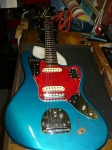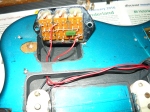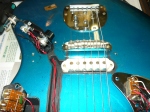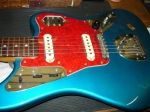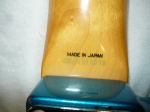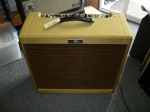Hello again. As a bit of a departure from talking about amps & pedals, this week we talk about service & repairs to solid body electric guitars. To be more specific, a Fender Jaguar made-in-Japan reissue (serial # N070078), which was recently delivered to the workshop by regular customer Hannes Leak. We have been repairing, rewiring, upgrading pickups and so on, to solid body electric guitars for many years – however, this is the very first time we have struck a Fender Jaguar (or even played one), so they have been a bit of a mystery until now.
Hannes had recently acquired this instrument on the 2nd hand market, however it appeared that the switching & controls were not functioning. To a Jaguar novice, the arrangement of controls is somewhat confusing – there are four slider switches and two sets of volume & tone controls – none of this is actually labelled so you have to read up on Jaguars to understand the intended functionality.
Basically, only one sound was apparently available regardless of which way the slider switches were set. It was as if one pickup had gone open circuit. To access any of the wiring, the switching or the pickups, it is necessary to remove the pickguard, which necessitates loosening off all the strings so that first the bridge can be removed. Both pickups measured 6.1K ohms, so obviously they were not the problem. A Jaguar schematic diagram was sourced from the Seymour Duncan site, actually specific to the original 60’s model. However, just to make things even more confusing, the Japanese reissue does not follow the original colour code – all the wiring is either red or black.
Some wiring is easily accessible in the various body cavities, some wiring is routed directly underneath the pickups, which are screwed directly into the body. So, in order to trace which wire goes where, visual inspection is not enough – the wires need to be traced with a multimeter. To start with, we replaced the corroded output jack with a shiny new Switchcraft. The rhythm circuit, located on its own control plate on the upper part of the body, appeared to be where we were losing signal. The single slider switch engages the front pickup only when switched upwards, which has preset volume & tone circuits. When switched downwards, the player can select either front or back pickups, or both, on the diamond shaped control plate on the lower part of the body, with a 3rd slider switch which attenuates the low frequencies for an even brighter tone. The output from this switch plate is controlled in the more conventional way by volume & tone controls located on the same control plate as the output jack. Phew !
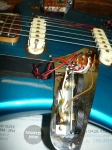
the rhythm circuit control plate – note the thumbwheel rotation of the preset volume & tone controls
We next replaced the rhythm circuit slider switch, but this was not the complete solution to our problems. There did not appear to be any earth return path for the rhythm circuit – perhaps they were relying on the conductive paint which is obvious in all the cavities to complete the circuit, but this was no longer working. To solve the problem once and for all, we ran a wire from the rhythm circuit control plate through to the output jack plate. All functionality was now restored, although all the pots plus the three slider switches on the diamond shaped plate required a good clean. To reassemble, it is necessary to loosen off the strings once more, reinstall the pickguard and the bridge, and reinstall the three control panels. At the end of it all, the tone was what you might expect – very bright & clean (perfect for ‘surf’ instrumentals ?) with limited sustain compared to Strats & Teles, not really applicable to hard rocking styles, and with a much less bright tone from the rhythm circuit. The slider switches don’t feel as positive as the 3-way & 5-way rotary switches employed on Strats & Teles. We rather liked the tone from the neck pickup.
Back in the day when the Jazzmaster & Jaguar were conceived, having preset ‘lead’ & ‘rhythm’ circuits made sense, as channel switching amps and pedalboards were still a long, long way into the future. To sum up for Jaguar newbies such as Hannes & myself, this is how it all works:
when the 2-way switch on the upper horn is in the UP position, you are playing through the RHYTHM circuit, neck pickup only, with volume & tone being controlled by the two thumbwheel pots on the upper horn
when the 2-way switch on the upper horn is in the DOWN position, you are playing through the LEAD circuit, which is controlled by the regular (ie rotary) volume & tone pots near the output jack, and the three separate 2-way switches located under the neck pickup, which are as follows (in order from closest to the neck) – neck pickup on/off, bridge pickup on/off, & high pass filter (ie bass cut) on/off.
